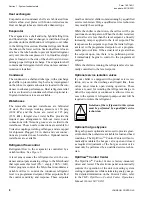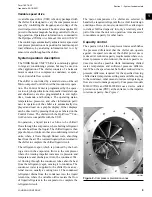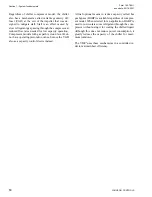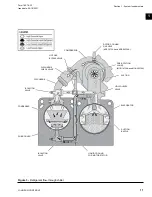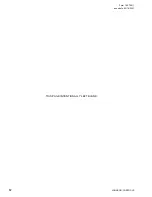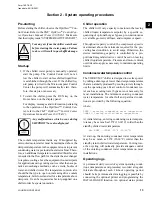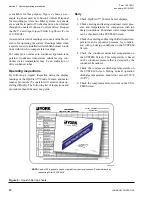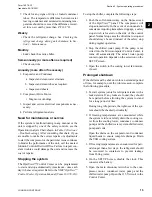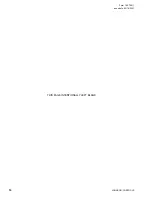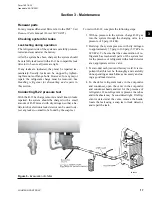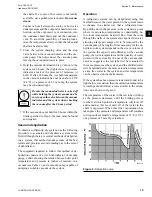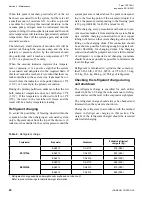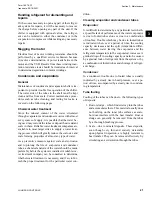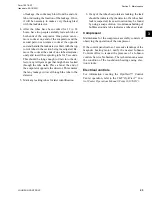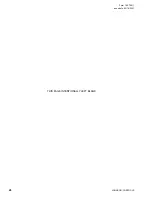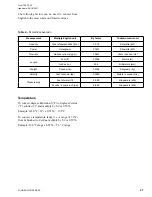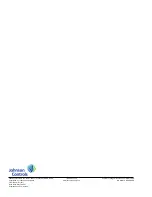
JOHNSON CONTROLS
22
Form 160.78-O1
Issue date: 05/19/2021
Section 3 - Maintenance
Tube cleaning procedures
Brush cleaning of tubes
If the tube consists of dirt and sludge, it can usually
be removed by means of the brushing process. Drain
the water sides of the circuit to be cleaned using cool-
ing water or chilled water, remove the heads, and thor-
oughly clean each tube with a soft bristle bronze or
nylon brush.
Do not use a steel bristle brush.
A steel
brush may damage the tubes.
Improved results can be obtained by admitting water
into the tube during the cleaning process. This can be
done by mounting the brush on a suitable length of
1/8 in. pipe with a few small holes at the brush end
and connecting the other end by means of a hose to the
water supply.
The tubes should always be brush cleaned before acid
cleaning.
Acid cleaning of tubes
If the tubes are fouled with a hard scale deposit, they
may require acid cleaning. Before acid cleaning, it is
important to clean the tubes using the brushing pro-
tively loose foreign material is removed before the acid
cleaning, the acid solution will have less material to
dissolve and flush from the tubes with the result that
a more satisfactory cleaning job will be accomplished
with a probable saving of time.
Acid cleaning should only be performed
by an expert. Consult your local water
treatment representative for assistance
in removing scale buildup and preventa-
tive maintenance programs to eliminate
future problems.
Commercial acid cleaning
In many major cities, commercial organizations now
offer a specialized service of acid cleaning evaporators
and condensers. If acid cleaning is required, use this
type of organization. The Dow Industries Service Divi-
sion of the Dow Chemical Company, Tulsa, Oklahoma,
with branches in principal cities is one of the most reli-
able of these companies.
Testing for evaporator and condenser tube
leaks
Evaporator and condenser tube leaks in R-134a sys-
tems may result in refrigerant leaking into the water
circuit, or water leaking into the shell depending on the
pressure levels. If refrigerant is leaking into the water,
it can be detected at the liquid head vents after a period
of shutdown. If water is leaking into the refrigerant,
system capacity and efficiency will drop off sharply. If
a tube is leaking and water has entered the system, the
evaporator and condenser should be valved off from
the rest of the water circuit and drained immediately to
prevent severe rusting and corrosion. The refrigerant
system should then be drained and purged with dry ni-
trogen to prevent severe rusting and corrosion. If a tube
leak is indicated, use the following steps to determine
the exact location of the leak:
1. Remove the heads and listen at each section of
tubes for a hissing sound that would indicate gas
leakage. This helps you to locate the section of
tubes that must be further investigated. If the
probable location of the leaky tubes has been de-
termined, treat that section in the following man-
ner. If the location is not definite, all the tubes
must be investigated.
2.
Wash off both tube heads and the ends of all tubes
with water.
Do not use carbon tetrachloride for this
purpose because its fumes give the same
flame discoloration that the refrigerant
does.
3. With nitrogen or dry air, blow out the tubes to
clear them of traces of refrigerant laden moisture
from the circulation water. As soon as the tubes
are clear, firmly insert a cork into each end of the
tube. Pressurize the dry system with 50 psig to
100 psig (345 kPa to 690 kPa) of nitrogen. Repeat
this with all of the other tubes in the suspected
section or, if necessary, with all the tubes in the
evaporator or condenser. Allow the evaporator or
condenser to remain corked up to 12 to 24 hours
before proceeding. Depending upon the amount
Summary of Contents for YMC2 A
Page 12: ...JOHNSON CONTROLS 12 Form 160 78 O1 Issue date 05 19 2021 THIS PAGE INTENTIONALLY LEFT BLANK ...
Page 16: ...JOHNSON CONTROLS 16 Form 160 78 O1 Issue date 05 19 2021 THIS PAGE INTENTIONALLY LEFT BLANK ...
Page 26: ...JOHNSON CONTROLS 26 Form 160 78 O1 Issue date 05 19 2021 THIS PAGE INTENTIONALLY LEFT BLANK ...

